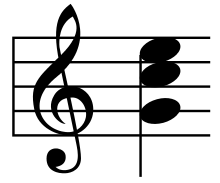Second inversion

4 chord

The second inversion of a chord is when the fifth of the chord is in the bass. For example, G in the bass of a C major chord. The bass note and the root of the chord are a fourth apart which traditionally qualifies as a dissonance. There is therefore a tendency for movement and resolution. In notation form, it is referred to with a c following the chord position (For e.g., Ic. Vc or IVc) or as a 6
4 chord (as in I6
4).
Types
There are 4 types of second inversions - cadential, passing, auxiliary and bass arpeggiation.
Cadential The chord progression typical of a cadential second inversion is Ic-V7-I. As is obvious from the term, it figures at the beginning of an authentic cadence. The notes of Ic above the bass are seen as a double appoggiatura on the V and they resolve down by step. Treated this way (as a double appoggiatura), it follows that the best note to double is the bass itself. The chord preceding Ic is most often a chord that would introduce V as a weak to strong progression. For e.g. - II-V (becomes II-Ic-V), IV-V (becomes IV-Ic-V)
Passing The bass occurs in passing between two tones a third apart (usually of the same harmonic function[1]). This is a typical use of Vc. In moving from Ia to Ib, in order to have a flowing movement of the bass, Vc is used (though some prefer VIIb to Vc). This creates a bass with the notes 1, 2 and 3 of the scale. It can also be used in the reverse direction from Ib to I. The important point is that it is used in passing between the two more stable chords. It occurs on the weaker beat between these two chords.[2] The upper voices usually move in step (or remain stationary) while this progression is in force.
Auxiliary This is a typical use of IVc. The usual progression is I-IVc-I. The 3rd and 5th rise a step each and then fall back. It creates a possible harmonization for the note movement 5-6-5.
Bass arpeggiation The bass moves between the 1, 3 and 5 of the chord. This is just a florid movement but since the 5 is present in the bass, it is referred to as a bass arpeggiation flavour of the second inversion.
References
Further reading
- Walter Piston, Harmony
- Aldwell and Schachter, Harmony and Voice Leading, 3rd Edition